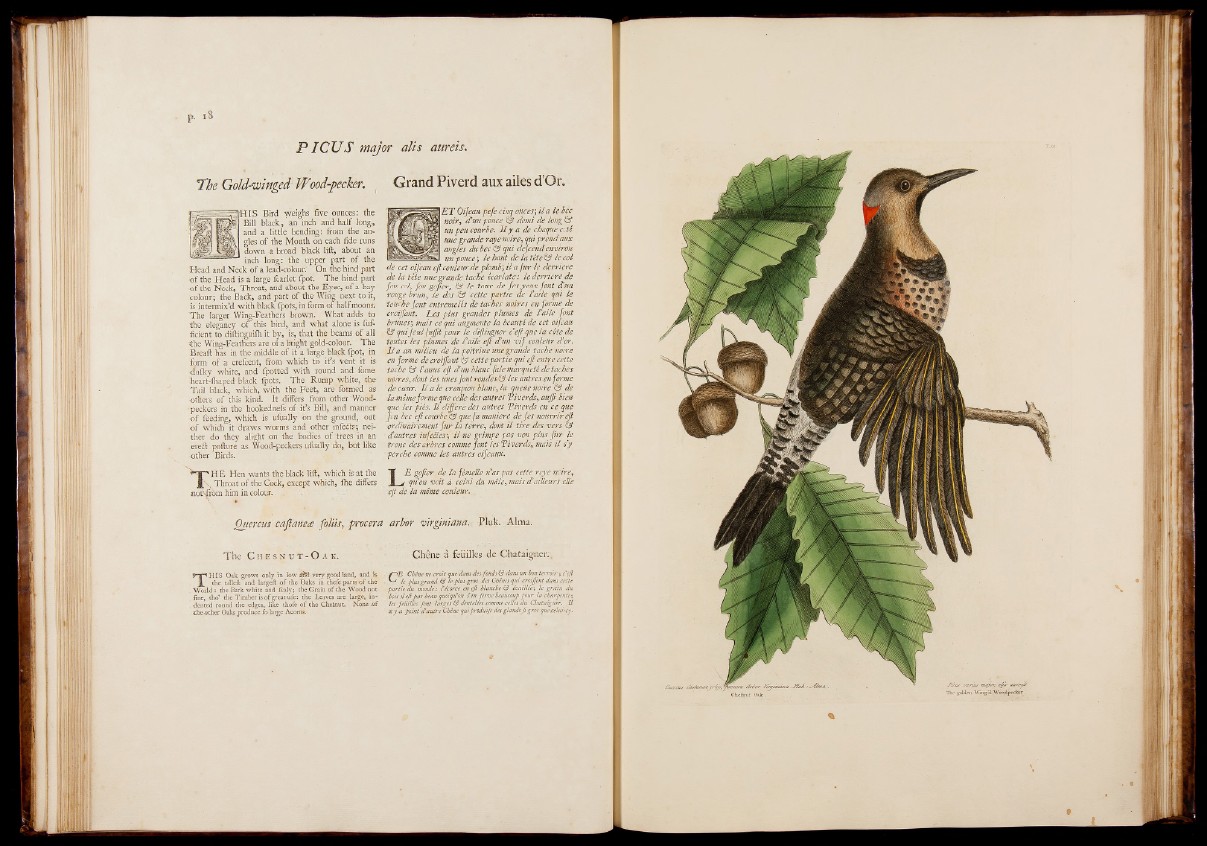
P I C U S major alls aureis.
The Gold-winged■ Woodpecker. ^ Grand Piverd aux ailes d’Or.
pH I S Bird weighs five ounces: the
Bill black, an inch and half long-,
and a little bending: from the angles
of the Mouth on each fide runs
down a broad black lift, about an
inch long: the upper part of the
Head and Neck of a lead-colour.' On the hind part
o f the Head is a large fcarlet ipof. The hind part
-of the Neck, Throat, and about the Eyes, of a bay
colour; the Back, and part of the Wing next to it,
is intermix’d with black fpots, in form of half moons.
The larger Wing-Feathers brown. What adds to
the elegancy of this bird, and what alone is fuf-
ficient to diftinguifh it by, is, that the beams of all
the Wing-Feathers are of a bright gold-colour. The
Breaft has in the middle of it a large black fpot, in
form of a creicent, from which to it’s vent it is
■dufky white, and fpotted with round and fome
heart-fhaped black fpots. The Rump white,: the
Tail black, which, with the Feet, are formed as
others of this kind. It differs from other ‘Woodpeckers
in the hookednefs of it’s Bill, and manner
o f feeding, which is ufually on the ground, out
o f which it draws worms and other inle&s; neither
do they alight on the bodies of trees in an
erefit pofture as Wood-peckers ufually do, but like
other Birds.
TH E Hen wants the black lift, which is at the
| Throat of the Cock, except which, fhe differs
notvfrom him in colour.
B E T Oifeau pefe cinq onces; i l a le bée
noir, d’un pouce & demi de long b 1
un feu courbe. I l y a de chaque cctê
une grande raye noire, qui prend aux
angles du bec & qui defeend emiron
un pouce le haut de la tête b 5 le col
de cet oifeau efi couleur de plomb; i l a fur le derrière
de la tête une grande tache écarlate : le derrière de
fon col, fon gofier, b 5 le tour de fes yeux font d ’un
rouge brun, le dos & cette partie de Vaile qui le
touche font entremêlés de taches noires en forme de
■croiffant. L e s plus grandes plumes de la i le font
brunes; mais ce qui augmente la beauté de cet oifeau
■&" qui Jeu l fußt pour le diflinguer c’efl que la cote de
toutes les plumes de l ’aile efi d ’un v if couleur d’or,
l i a au milieu de la poitrine unegrande tâche noire
en forme de croiffant b* cette partie qui efi entre cette
tache b l ’anus efi d?unblanc fale marqueté détachés
noir es, dont les unes font rondes^ les autres en forme
: de coeur. I l a le croupion blanc, la ' qneûe noire de
la même forme que celle des autres Tiverds, auß bien
que. les fiés. I l différé des autres; Tiverds en ce que
Jen bec éft courbeb que fa maniere de fes nourrir efi
ordinairement fu r la terre, dont il tire des vers b
• dautres infédes ; 'i l ne grimpe pets non plus fu r le
tronc des arbres comme, font lè s riverds9 mais il s'y
perche comme les autres oifeaux.
LU gofier de la fémette n’as pas cette raye noire,
qu’on voit à celui du mâle, mais d ’ailleurs elle
efi de. la même couleur...
Quer eus caftanea foliis, procera arbor virginiana. Pluk. Alma.
The C h e s n u t -O a k . Chêne à* feuilles -de Chataiguer;*
T H IS Oak grows only in low very good land, and is jOE Chêne ne croit que dam des fonds&Mans un bon terroir j c ejl
the talleft and largeft o f the "Daks in thefe part-s o f the V le. plus grand & le plus gres des Chênes ■qui -croisent dans cette
World : the Bark white and fcaly; the Grain o f the Wood non partie du mondé: l’écorce enejl. blanche & écaillée-, le grain du
fine, tho’ the Timber is o f great ufe: the Leaves are large, in- lois neflpas beau quoiqu'on sen fcrve beaucoup pour la charpente-,
dented round the edges, like thofe o f the Cheinuc. ' None o f les JeüimsJmt-Jargèf&Âintelées comme celles du Chataigner. I l
iheocher Oaks produce fo large Acorns. « y -a point d'autre Chêne fuiproduije des glands jigros quecelui-cy.
■vzam ¿Zrézrr /
Gheiaut Oak
<2tj/astereyv/tftp